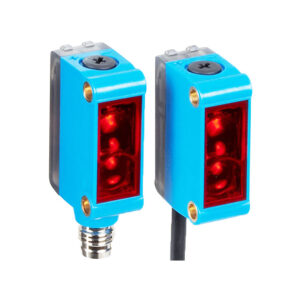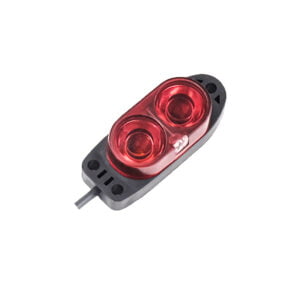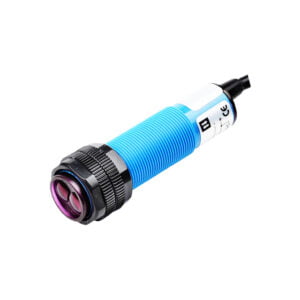As one of the three different types of photoelectric sensors, the diffuse photoelectric sensor plays a very important role in object detection. Compared with other retro-reflective and through-beam photoelectric sensors, diffuse photoelectric sensors combine the transmitter and receiver into one, which is compact, space-saving and easy to use.
In the next section, we will provide a detailed explanation of the sensor in 6 aspects: what it is, how it works, its advantages and disadvantages, applications, wiring diagrams, and the differences between it and reflective photoelectric sensors.
What is a diffuse photoelectric sensor?
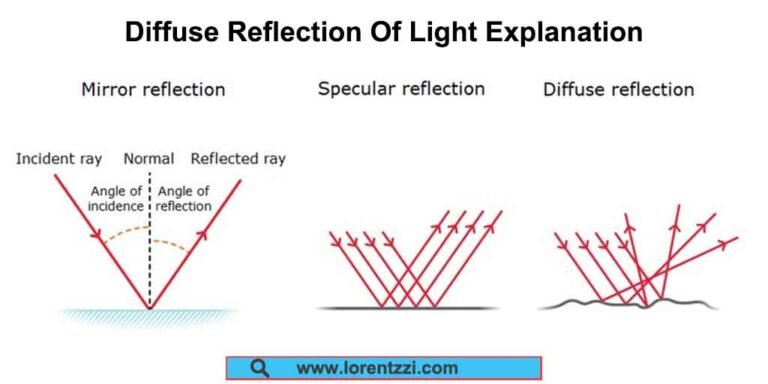
A diffuse photoelectric sensor is a sensor that uses the principle of diffuse reflection of light to detect the presence of an object.
Diffuse sensor working principle
The diffuse photoelectric sensor contains two main components: the transmitter and the receiver.
Its working principle is: the transmitter emits a beam of light (the light source can be infrared light, LED light or laser), and when the target object enters the detection area, the light is reflected from the surface of the object back to the sensor’s receiver. If the receiver detects the reflected light of sufficient intensity, it triggers an output signal for controlling or monitoring the relevant process.
Diffuse photoelectric sensor advantages and disadvantages
The diffuse photoelectric sensor has advantages and disadvantages like following:
Pros:

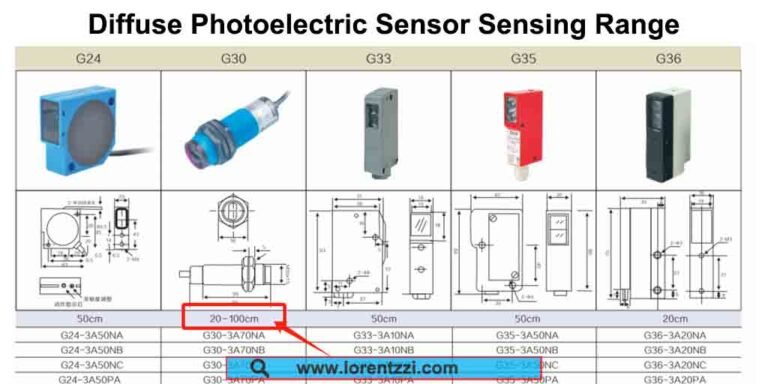
- Long detection distance: Compared to inductive or capacitive proximity sensors, the diffuse photoelectric sensors have a much longer detection distance. Generally speaking, the maximum detection distance of inductive and capacitive proximity sensors is only 20 mm-30 mm, while the detection distance of diffuse photoelectric sensors provided by Lorentzzi ranges from 70 mm to a maximum of 1000 mm.
- No contact with objects: Since diffuse photoelectric sensors use light to detect objects and do not directly contact the detected objects, wear and tear on the sensors and detected objects is effectively avoided.
- Not affected by the object material: this sensor can be used to detect plastic, metal, wood, powder and other materials.
Cons:
- Susceptible to dust: Since photoelectric sensors use light to detect objects, this means that once its receiver is blocked by dust, it is easy to cause false detection. Therefore, in order to avoid this, we must ensure that this sensor is used in a very clean environment.
- Sensitive to ambient light: The lighting conditions of the working environment will affect its measurement accuracy and stability. For Lorentzzi® and other branded infrared light diffuse reflection photoelectric sensors, the ambient light should be less than 10,000 Lux; for laser light diffuse reflection photoelectric sensors, the ambient light should be less than 5,000 Lux.
Light-on And Dark-on Mode Explanation in Diffuse Sensor
All types of photoelectric sensors support light-on and dark-on modes, but what exactly are they? How do they work in diffuse sensors?
These two working modes are based on whether the receiver can receive the emitted light.
Light-on mode: For diffuse sensors, light-on means that its output will be activated when the returning light is able to be received by the receiver. For example, if your diffuse sensor has a normally open output, when the receiver receives the reflected light, the output will change from normally open to normally closed.
Dark-on mode: Dark-on is the opposite of light-on, for example, if you use this mode and your sensor has a normally open output, once the light is blocked and cannot return to the receiver, its output will change to a normally closed state.
What is the difference between diffuse and retro-reflective sensors?
The working principle of the diffuse and retro-reflective sensors is nearly the same, they all use the reflected light to check whether there is an object or not. But there are still 3 differences, see below:
- Diffuse sensors use light diffusely reflected from the object itself to detect the presence of an object, while retro-reflective sensors utilize a reflector as the reflected light source.
- Usually the diffuse sensors work on a light-on mode basis, where when the receiver detects returning light, it activates the output, whereas reflective sensors work on a dark-on mode, where the output activates once the light between the sensor and the reflector is blocked.
- For photoelectric sensors of the same size, the detection distance of diffuse type is smaller than that of retro-reflective type. For example, the detection distance of our G18 diffuse reflection photoelectric sensor is 30mm, while the detection distance of our G18 mirror reflection photoelectric sensor can reach 2000mm.
How to wire a diffuse photoelectric sensor?

According to the different output modes, diffuse reflection photoelectric sensors can be divided into NPN type and PNP type:
PNP type (source output):
When the sensor detects the target object, the output end provides a high voltage (that is, the output current flows from the sensor to the load).
Wring method: One end of the load is connected to the output end of the sensor, and the other end is grounded.
NPN type (sink output):
When the sensor detects the target object, the output end pulls down the voltage (that is, the output current flows from the load to the sensor).
Wiring method: One end of the load is connected to the output end of the sensor, and the other end is connected to the positive pole of the power supply.
Conclusion
In summary, diffuse photoelectric sensors are one of the most widely used proximity sensors in the field of industrial automation. Relying on them, we can clearly know the position, quantity and other information of the detected objects, so that we can accurately control the entire automation system.
At Lorentzzi, we can provide all kinds of diffuse photoelectric sensors, the sensing range is from 70 mm to maximum 1000 mm. If you will need our technical support or need us to provide a quote, please contact us for free!


